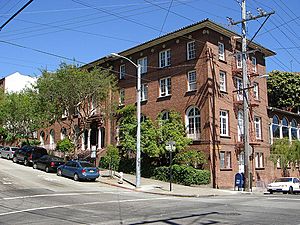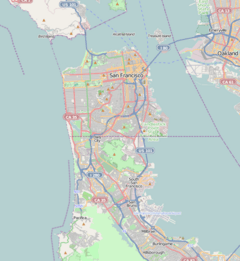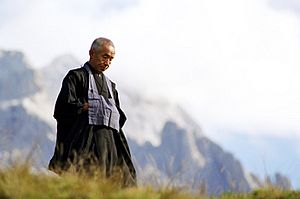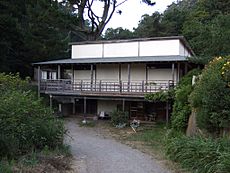San Francisco Zen Center facts for kids
Quick facts for kids San Francisco Zen Center - City Center |
|
|---|---|
 |
|
| Religion | |
| Affiliation | Sōtō |
| Location | |
| Location | 300 Page St., San Francisco, CA 94102 |
| Country | United States |
| Architecture | |
| Architect(s) | Julia Morgan |
| Founder | Shunryu Suzuki |
| Completed | 1922 |
| Website | |
| www.sfzc.org | |
The San Francisco Zen Center (SFZC) is a group of Sōtō Zen practice and retreat centers. These centers are located in the San Francisco Bay area. They include City Center (also called Beginner's Mind Temple), Tassajara Zen Mountain Center, and Green Gulch Farm Zen Center. Shunryu Suzuki Roshi and his American students started the group in 1962. Today, SFZC is the largest Soto Zen organization in the Western world.
History of the Zen Center
How the San Francisco Zen Center Started
On May 23, 1959, Shunryu Suzuki came from Japan to San Francisco. He was 55 years old. He became the head priest of Sokoji, a Soto Zen temple. His wife, Mitsu, joined him from Japan in 1961.
Sokoji was in a building that used to be a Jewish synagogue. When Suzuki arrived, the people who attended Sokoji were all Japanese-American. Unlike many other priests, Suzuki spoke English very well.
Growth and Change in the Community
Suzuki arrived during a time of big social changes in San Francisco. Soon, non-Japanese Americans, many of them young people called "beatniks," started coming to the temple. They came to sit zazen (meditate) with him in the mornings.
These Western students began to join the regular services. Soon, there were more non-Asian students than Japanese-American ones. This change caused some disagreements in the Sokoji community. To help, Suzuki's Western students began having their own separate services in 1961. They still met at Sokoji. Some of these students started calling their group City Center. They officially formed the San Francisco Zen Center in 1962.
Founding New Practice Centers
The number of people practicing at SFZC grew very quickly in the mid-1960s. Within a few years, Suzuki thought about starting a monastery. This would be a place for students who wanted to practice more deeply.
In 1966, Suzuki and a student named Richard Baker looked for a place. They found Tassajara Hot Springs in the Los Padres National Forest. It was a possible spot for the new monastic center. After a big effort to raise money, led by Baker, Zen Center bought the land in 1967. The land had an old resort and mineral springs. Tassajara Zen Mountain Center was the first Zen Buddhist monastery built in the United States. It was also the first in the world to allow both men and women to practice together.
In 1967, Kobun Chino Otogawa came from Eiheiji, Japan. He worked as an assistant to Suzuki. Kobun was a teacher at Tassajara Zen Mountain Center until 1970. Around 1970, he began meditating with a group in Santa Cruz. This group later became the Santa Cruz Zen Center.
Another assistant priest at SFZC was Dainin Katagiri-roshi. He worked there from 1969 to 1971. Katagiri later started his own practice center. It was called the Minnesota Zen Center in Minneapolis, founded in 1972.
Moving to a New City Center Building
In 1969, the leaders of Sokoji asked Suzuki to leave his position. They felt he was spending more time with his Western students. Months later, Suzuki and his American students bought a new, larger building for City Center. It is located at 300 Page Street.
The building was designed by Julia Morgan and built in 1922. It was originally a residence club for Jewish women. It had rooms for 70 women on the upper floors. The ground floor and basement had public spaces for spiritual, fun, and educational uses. This layout worked well for the San Francisco Zen Center. Meditation halls and public areas were on the lower levels. Residential areas for students were on the upper floors.
Leadership and Suzuki's Legacy
In 1970, Suzuki passed on his teachings to Richard Baker. Baker was his only American student chosen to continue his work at SFZC. Suzuki died of cancer on December 4, 1971, at age 67.
Even though he was in the United States for only 12 years, Suzuki did a lot to establish Soto Zen in America. His death happened shortly after his book, Zen Mind, Beginner's Mind, was published. This book is a collection of his talks. It has been translated into many languages and is a classic book about Zen.

Suzuki had asked Baker to find a farm nearby. This farm would be a place where whole families could live a Buddhist life and work together. Green Gulch Farm was bought by SFZC in 1972. It is located in Sausalito, California, in a valley near the Pacific Ocean.
Members raised money to build a zendo (meditation hall) there. Over time, the farm became a monastery and retreat center. It has an organic farm, flower gardens, a teahouse, and a plant nursery.
Zen Center Businesses
In 1976, SFZC bought the Gallo Pastry Company. They started the Tassajara Bakery. This bakery became very popular. It was sold in 1992 and closed in 1999. The bakery was an idea from Richard Baker. It grew from the baking practices at Tassajara Zen Mountain Center. Tassajara had baked bread for students and guests since 1967. A book called Tassajara Bread Book showed that people were interested in their baking.
Greens Restaurant opened in 1979 in Fort Mason of San Francisco. This was another business started by SFZC under Baker's influence. It was a leader in gourmet vegetarian cuisine in America. The restaurant's first chefs were Edward Espe Brown and Deborah Madison. They published a cookbook in 1987 called The Greens Cookbook. Greens Restaurant got its fresh food from Green Gulch Farm. Throughout the 1980s, it was one of the most popular restaurants in San Francisco.
In 1984, there was a change in leadership at SFZC. Richard Baker, who was the abbot, resigned. After this, SFZC changed to a system where leaders were chosen by a vote. In 2010, they started a new system where board members were chosen ahead of time.
SFZC Today
In 2000, Jiko Linda Cutts became the Abbess. In 2003, Paul Haller became co-abbot with her.
Zen Hospice Project
In 1987, SFZC started the Zen Hospice Project. This is a volunteer program that helps people at the end of their lives. It runs out of a guest house on Page Street with five beds. The project also trains volunteers. These volunteers provide kind, non-medical care to people in hospice and palliative care at Laguna Honda Hospital. This hospital is run by the City and County of San Francisco.
The Zen Hospice Project helps people of any religion, or no religion, who are looking for a caring end to their life. Today, SFZC is the largest Soto organization in the West. The Zen Hospice Project was featured in a 2018 Netflix documentary called End Game. The film showed the work of doctors and caregivers helping people who are very sick.
Tassajara Zen Mind Temple
The Tassajara monastery is closed to visitors from September through April. It opens to the public by reservation from May through August. Students who come to practice at the monastery from September through April must go through a tradition called tangaryo. They will sit in the zendo (meditation hall) for five days or more before they are officially allowed into the monastery. This can be a very challenging experience.
Green Gulch Green Dragon Temple
The organic farm at Green Gulch provides food to local restaurants and stores. It also sells flowers, produce, and herbs at the Ferry Plaza Farmers Market in San Francisco. Guests can stay at the Lindisfarne Guest House. This is a traditional Japanese building with a wood-burning stove for heat. Guests do not have to practice Zen to stay at Green Gulch. However, they are welcome to join in zazen or other activities. Tenshin Reb Anderson-roshi, a former abbot, is a senior teacher at Green Gulch. He trains priests and laypeople, leads retreats, gives talks, and holds workshops. He also lives on site.
Friends of SFZC
SFZC is connected to the following Zen Centers:
- Berkeley Zen Center
- Brooklyn Zen Center
- Chapel Hill Zen Center
- Hartford Street Zen Center
- Kannon Do Zen Meditation Center
- Santa Cruz Zen Center
- Sonoma Mountain Zen Center
- Austin Zen Center
- San Antonio Zen Center
- Houston Zen Center
- Dharma Vow Zen Sangha, Santa Monica
Alumni - partial list
| Shunryu Suzuki (founder) | Zentatsu Richard Baker | Edward Espe Brown | Kobun Chino Otogawa | Taigen Dan Leighton |
| Jakusho Kwong | Sojun Mel Weitsman | Tenshin Reb Anderson | David Chadwick | Seirin Barbara Kohn |
| Ryushin Paul Haller | Philip Whalen | Jiko Linda Cutts | Zoketsu Norman Fischer | |
| Dainin Katagiri | Josho Patricia Phelan | Zenkei Blanche Hartman | Hozan Alan Senauke | |
| Wu Bong (Jacob Perl) | Furyu Nancy Schroeder | Fenton Johnson | Yvonne Rand | Maylie Scott |
| Issan Dorsey | Angie Boissevain | Joanne Kyger | Dairyu Michael Wenger | Gil Fronsdal |
See also
- Zen in the United States
- Buddhism in the United States
- Bush Street Temple
- Hartford Street Zen Center
- Kannon Do Zen Meditation Center
- Timeline of Zen Buddhism in the United States
- List of works by Julia Morgan







